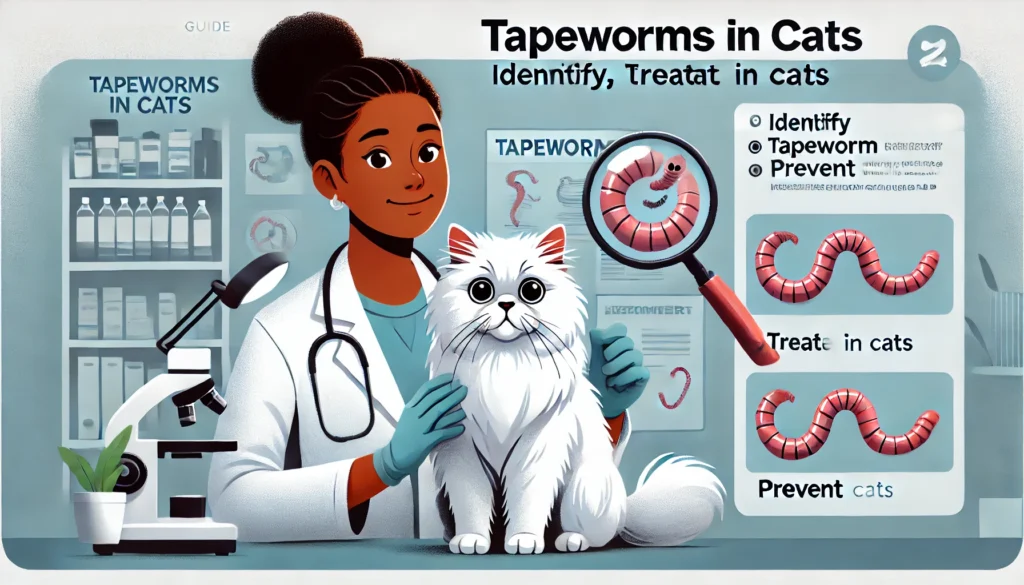Tapeworms in Cats: Comprehensive Guide to Detection, Treatment, and Prevention

Tapeworms are a prevalent issue in felines that can cause significant discomfort and health problems. Understanding the nature of tapeworms, recognizing the symptoms, and knowing how to treat and prevent these parasites are crucial for keeping your cat healthy. This article provides a detailed look into the world of tapeworms in cats, including types, symptoms, treatments, and preventive measures.

Understanding Tapeworms in Cats
Tapeworms, scientifically known as Dipylidium caninum and Taenia taeniaeformis, are intestinal parasites that are commonly found in cats. Cats often acquire tapeworms through the ingestion of an intermediate host, like a flea or a small rodent, which carries tapeworm eggs. Once inside the cat’s intestine, the larvae hatch and attach to the intestinal lining, growing into adults that can reach several inches in length.
Types of Tapeworms
- Dipylidium caninum: This is the most common type of tapeworm found in cats and is generally transmitted via fleas.
- Taenia taeniaeformis: Cats contract these tapeworms through the consumption of infected rodents or raw meat.
- Echinococcus: Though less common, these tapeworms are important due to their zoonotic potential—meaning they can be transmitted to humans.
Symptoms of Tapeworm Infection
Infected cats may not show symptoms initially, but as the tapeworms grow, symptoms can become more apparent:
- Weight loss and increased appetite: Despite an increase in food intake, affected cats may lose weight.
- Vomiting and diarrhea: Gastrointestinal distress is a common symptom of many parasitic infections, including tapeworms.
- Visible segments in feces or fur: Often described as looking like rice grains or sesame seeds, tapeworm segments may be found in the cat’s stool or clinging to the fur around the anus.
- Lethargy and general malaise: Infected cats may seem less energetic or unwell.
Diagnosis and Treatment
Diagnosing tapeworms typically involves a visual identification of the segments in the cat’s feces or around its anus. A veterinarian can also perform a fecal exam to look for evidence of tapeworm eggs. Treatment is straightforward and involves administering an anthelmintic (dewormer) that specifically targets tapeworms, such as praziquantel or epsiprantel. These medications dissolve the tapeworms within the cat’s intestines.
Prevention of Tapeworms
Preventing tapeworms in cats includes several key practices:
- Flea control: Regular use of flea control products is essential, as fleas are the primary vector for Dipylidium caninum.
- Avoid feeding raw or undercooked meat: This can prevent Taenia and other types of tapeworm infections.
- Regular deworming: Scheduled deworming treatments can help eliminate any tapeworms before they become a serious issue.
- Maintain a clean environment: Regularly clean and vacuum areas where your cat spends time to help reduce the risk of tapeworm transmission.
DO YOU KNOW
Polydactyl cats are more than just a curiosity; they are a delightful anomaly in the feline world. With their unique paws and historical significance, these cats offer a special kind of companionship.
Risks and Considerations
While tapeworms are generally not deadly, they can cause significant discomfort and lead to more serious health issues if left untreated. In rare cases, certain types of tapeworms can also pose risks to human health, especially for children and immunocompromised individuals.
Conclusion of Tapeworms in Cats
Understanding tapeworms in cats is key to effectively managing this common parasitic condition. With proper care, prevention, and timely treatment, you can help ensure your cat remains healthy and tapeworm-free. Always consult with a veterinarian if you suspect your cat has tapeworms, as professional diagnosis and treatment are crucial for effective management and prevention of further health complications.
Can I deworm my cat of tapeworms?
Yes, you can deworm your cat of tapeworms using specific antiparasitic medications that your vet can prescribe, such as praziquantel or epsiprantel. These medications are highly effective at eliminating tapeworms.
Can I sleep with my cat if it has tapeworms?
It’s generally safe to sleep with your cat, as direct transmission of tapeworms from cats to humans is unlikely. However, maintaining good hygiene and ensuring that your cat is treated for tapeworms and fleas is advisable to minimize any risk.
How can you get rid of tapeworms in a cat?
Administer prescribed deworming medication as directed by your veterinarian. It’s also crucial to control fleas, as they are often the carriers of tapeworm eggs.
How do you know if a cat has tapeworms?
Signs include visible segments of the worm around the cat’s anus or in its feces, which may look like small, white, rice-like grains. You might also notice weight loss or changes in appetite.
Can humans catch tapeworms from cats?
Yes, but it’s rare. Humans can get tapeworms through accidental ingestion of infected fleas, not directly from cats. Children are at higher risk due to their closer contact with pets and potentially less thorough hygiene.
Do cats survive tapeworms?
Yes, cats can survive tapeworms, especially with proper treatment. Tapeworm infections are typically not life-threatening.
Can I touch my cat if it has tapeworms?
Yes, you can touch your cat. Tapeworms are not transmitted through touch but through the ingestion of infected fleas.
Do tapeworms make a cat feel bad?
Tapeworms can cause discomfort and symptoms like irritation around the anus, but many cats with tapeworms do not show obvious signs of feeling unwell.
Do cats with tapeworms eat more?
Infected cats might show an increase in appetite due to nutrient loss caused by the parasites consuming some of the food ingested by the host.
What kills tapeworms?
Medications like praziquantel and epsiprantel are effective at killing tapeworms in cats. These are available through your veterinarian.






